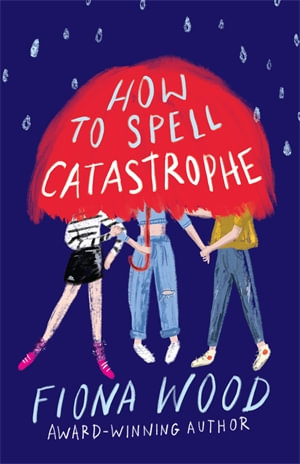How to spell catastrophe by Fiona Wood

How to spell catastrophe is the debut middle-grade novel by YA Australian author and screenwriter Fiona Wood. Like Nova Weetman's The edge of thirteen this book will be a popular choice for girls aged from 10 years as they grapple with bodily changes, hormones, friendship woes and other struggles and delights of the Middle Years of schooling. With the greatest of sensitivity, it is suggested that this book is really for girls. When talking about it with classes, it was suggested that boys could be interested only if they wanted to know more about girls... and this suggestion was met with much foot shuffling and bashful camaraderie. It is noted however that Wood dedicated this book to two boys. Perhaps she has in mind, a readership of boys who are more aware of the issues concerning girls.
Wood goes, through the first person voice of Nell, to places that girls on the brink of adolescence fear and probably don't care to talk about even with their friends. How to spell catastrophe is therefore a comforting and instructive book for every pre-teen and tween age girl. Similar to the cover of The edge of thirteen, the cover of How to spell catastrophe suggests the feminine nature of the contents. Astred Hicks, Sydney-based graphic and freelance book designer, has created a cover featuring three girls sheltering and supporting one another under a large, red umbrella against a dark blue background complete with rather oversized raindrops. Rather appropriate!
The text is very accessible to the reader. Woods has the teenage vernacular down pat. Poor Nell McPherson, a grade sixer, is our protagonist and the reader sees life through her eyes as she copes with all the worries of the world. Nell states in the prologue. 'I'm still more of a worrier than a warrior.' She keeps a diary so the narrative is interspersed with her notes that appear to be kept in a spiral bound notebook and are about various catastrophes and the solutions to them. Occasionally, we read the contents of text conversations. She loves words and occasionally she chooses a word that is appropriate to her situation, defines it, puts her problem into writing, plans, gives her week a 'fruit ranking' and writes down what she is grateful for. Openly she talks about how she has seen a psychologist all her life when she needs help with strategising and coping with the worries that stem from the death of her father when she was two. This frank and open writing about seeking specialist help with social/ emotional/ thinking skills normalises what still can be a no-no subject in some places. This too is a comfort for the large and growing group of young people who we know are struggling with anxiety.
How to spell catastrophe is a novel that delivers, through the voice of Nell, much warmth and good advice. It's full of humour and looks at life through an optimistic lens. The adults in the book, from the teacher, Alex, to the parents are real and good characters. Wood has created such an authentic view of the current typical year 6 classroom and the interactions within, one wonders whether she has been a fly on the wall. The battle that Nell takes on re climate activism and the role models that she admires constitute another contemporary component of this story.
Recommended for grade 6+
Themes: Blended families, Climate action, Friendship dynamics, Identity.
Wendy Jeffrey